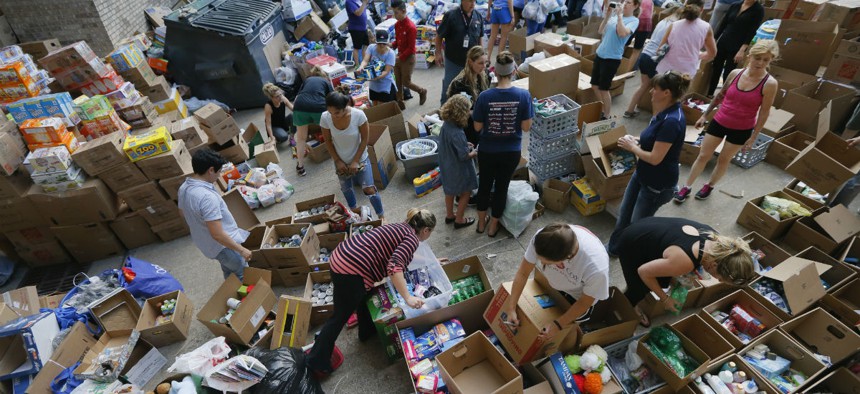Trump’s Harvey Dilemma
The flood insurance program is expiring just as the president and Congress will need to figure out how to fund Houston’s recovery.
A decade ago, my wife and I finally escaped on a long-delayed week away. We picked Bermuda because it had beautiful water, offered cheap off-season prices, and was a short hop. When we settled into our plane seats, we saw lots of other casually dressed tourists. But we were surprised to also see a large number of well-dressed women and men in expensive dresses and suits. They obviously weren’t heading to the beach.
They were flying to Bermuda on business, and in Bermuda business means reinsurance—the insurance companies that insure other insurance companies for mega-losses. Fifteen of the world’s top 50 reinsurance companies are located there. And in Hurricane Harvey’s wake, they’re a mighty nervous bunch. Losses from the storm, some experts are guessing, could total $100 billion, more than Superstorm Sandy.
And that, in turn, is framing two huge policy dilemmas for the Trump administration. The first dilemma is obvious: how the administration will deal with the enormously contentious question of how to pay for Houston’s rebuilding. The legislative battle won’t be easy. Many members of the state’s congressional delegation had opposed aid to the Northeast in the wake of Superstorm Sandy. The price tag will be enormous at a time when Trump has pledged to dial down spending. And the president has threatened to shut down the government if the must-pass funding bill doesn’t pay for his wall—a wall many Texans living near the border didn’t want to begin with.
But the bigger, hidden, and nastier dilemma is the one that Bermuda’s reinsurers are worried about down the road. More Americans are living in flood-prone areas than ever before. Flood-prone areas are flooding more often. Houston, in fact, is now experiencing its third “500-year flood” in three years. Most Americans don’t buy flood insurance, including about 80 percent of Harvey’s victims in Houston. FEMA’s National Flood Insurance Program is insolvent—and it has to be reauthorized by Sept. 30.
The big dilemma isn’t just how to pay for Harvey’s destruction. It’s what conditions to put on the money for rebuilding and how to reduce the inevitable risks down the road.
The Trump administration saw this problem coming. On Aug. 15, the president signed an executive order rolling back the Obama administration’s expansion of flood mapping and limits on building in floodplains. Builders hated those restrictions. A week later, before Harvey emerged as a major threat, FEMA Administrator Brock Long called for a stronger state role in covering the cost of flood disasters, in an effort to take some of the load off his agency. He also argued that the feds shouldn’t continue to pay to rebuild properties that flood repeatedly.
The flood insurance program is expiring just as the president and Congress will need to figure out how to fund Houston’s recovery. Many analysts say the solution is to rely more on markets: to provide homeowners and business operators with more information, improve incentives for buying protection in private insurance markets, and dramatically shrink the government’s role in writing big checks after massive disasters. A private-sector president might be drawn to such a market-based solution. But that solution requires steps Trump is unlikely to take: more effectively mapping flood risks; recognizing that climate change is causing sea levels to rise, which puts more properties at risk; and placing more restrictions on who can build where. Those would be tough moves for this administration.
The alternative is to rely more on government—but not the federal government. The federal government could shift responsibility to state and local governments and, for its part, back away from identifying the risks or restricting development in flood-prone areas. But that would likely encourage more development and put more people in harm’s way. It would ask state governments to pay for damages far beyond their fiscal capacity. And, with some states (like Texas) cracking down on efforts by local governments to impose new restrictions on development, it could cause the state-based strategy to stall. Then, as was the case with Andrew, Katrina, Sandy, and now Harvey, the federal government would end up footing the bill without having reduced the risk it will have to pay for. The result will be higher costs and more misery for everyone.
The president has promised to help Houston, and heaven knows its people need it. Getting that help through Congress won’t be easy. But as that battle brews, the bigger dilemma will be bubbling below the surface. Will the Trump administration lean toward the private-insurance solution, but grudgingly accept the inevitable embrace of climate change science and flood mapping that it requires? Or will the Trump administration stand on its rejection of climate change and its insistence on passing more responsibility on to the states—and still find itself repeatedly on the hook for enormous costs it missed the chance to control?
The reinsurers in Bermuda, who work with the insurance companies around the world who share the costs of the decision, will be anxious to see how this turns out.




